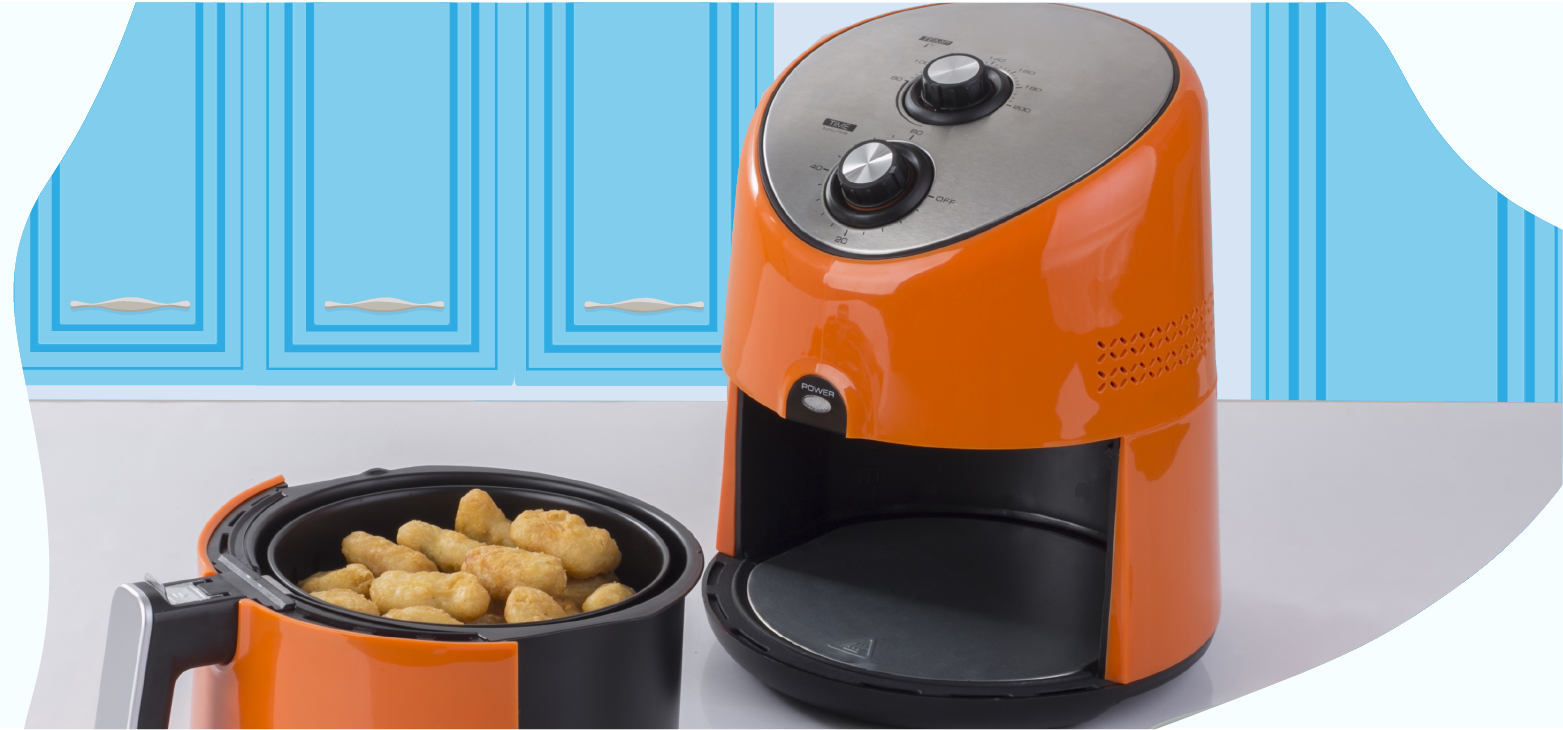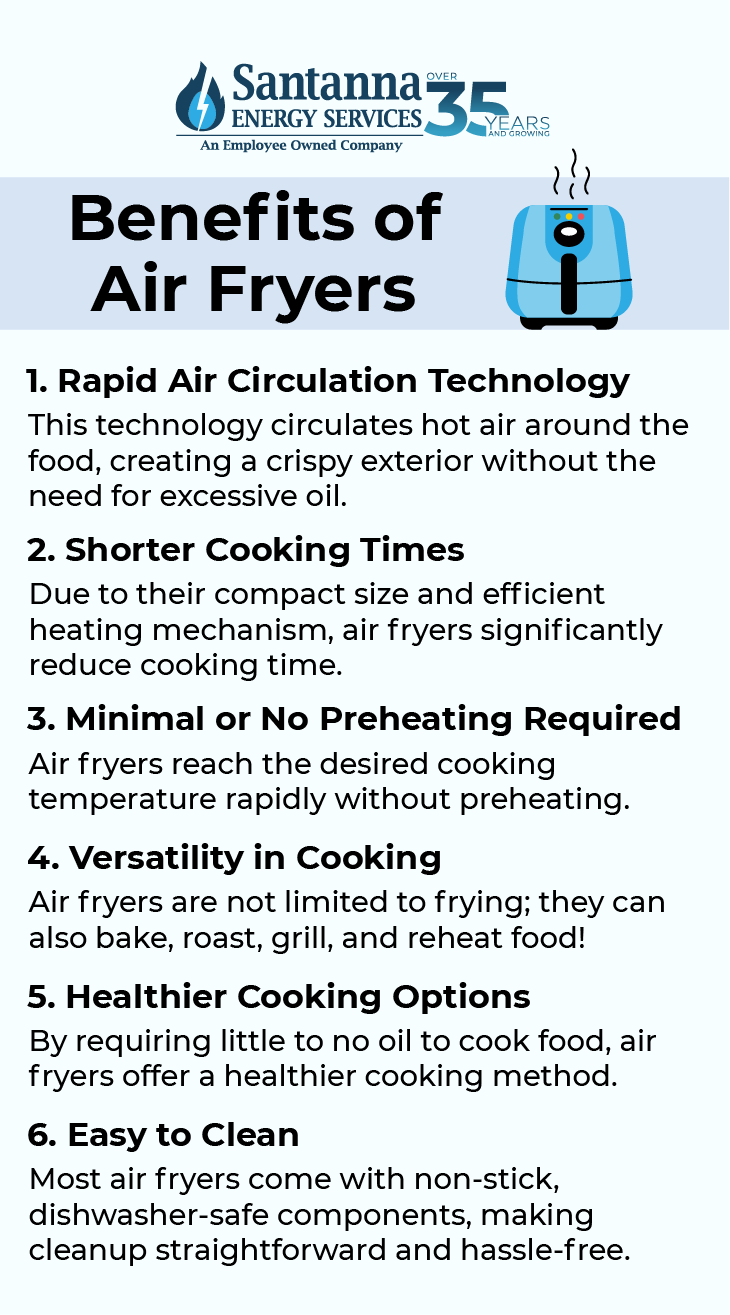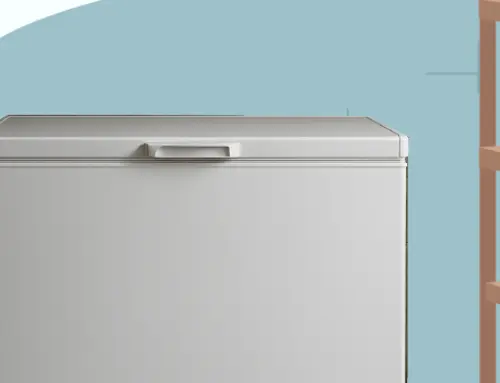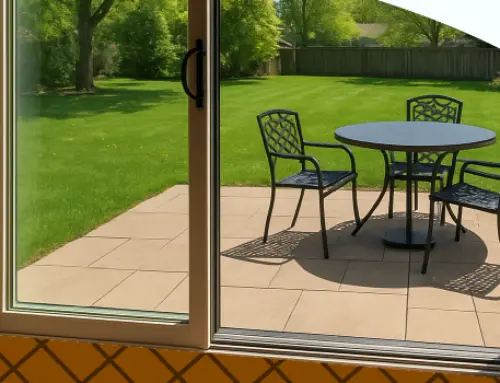Do Air Fryers Use a Lot of Electricity?
by Tyler Castle
21.1 min read

Air fryers have taken kitchens by storm, offering a faster and healthier way to enjoy crispy, delicious meals without the mess and extra oil of deep-frying. But beyond their convenience and health claims, many wonder: do air fryers use a lot of electricity?
If you’re considering adding an air fryer to your countertop, it’s natural to ask how it might impact your energy bills—or if it’s truly more efficient than using your oven or microwave. In this guide, we’ll break down the facts about air fryer electricity usage, compare them to other common appliances, and explore whether they’re worth the investment for your cooking needs.
By the end, you’ll have a clear understanding of how much power air fryers use, what factors affect their energy consumption, and how to choose the most efficient option, allowing you to confidently decide if an air fryer is the right fit for your kitchen.
Types of Air Fryers
Air fryers come in three main styles, and each design can impacts how much energy they use. Factors like size, cooking capacity, and extra features play a role in how long they run and how much power they draw.
1. Basket Air Fryers
One of the most common types of air fryer models is the basket air fryer. These are the classic, single-basket models most people picture when they think of an air fryer. They're simple and compact, using a powerful fan to circulate hot air around your food inside a removable basket.
With their compact design, single-basket air fryers use less counter space and are ideal for small households or individuals looking for a quick meal. Because of their small sizes, single-basket fryers tend to use less electricity than their bigger counterparts. But be aware that the smaller the appliance means you might need to cook in batches for large meals, which could increase total energy use if running multiple cycles.
2. Dual-Basket Air Fryers
These models feature two separate cooking baskets within the same air fryer. Often with independent controls for time and temperature, a dual basket fryer allows you to cook different foods at once or sync them to finish cooking together.
The best thing about dual-cooking air fryers is that you can cook two dishes at once without mixing flavors. In the same way, independent settings let you save time and take the guesswork out of timing your dishes compared to cooking batches.
Dual-basket air fryers are ideal for bigger families who need more cooking space. This model can be considered more energy-efficient for multi-item meals than a single-basket air fryer since you might only need to run your dual-basket air fryer once to get the job done.
3. Air Fryer Toaster Ovens
These are multi-purpose appliances that combine air frying with functions like baking, broiling, toasting, and roasting. They're shaped like a small oven with racks or trays instead of a basket.
Air fryer toaster ovens can be extremely helpful for those who prefer larger or wider food items that can't fit in a basket fryer (think pizza and pie!) These models are also multi-functional, which means you may need fewer appliances in your kitchen and generate less energy waste. An air fryer toaster oven is better for baking or roasting and may cook more food in one cycle than your huge oven appliance which can reduce total energy use for big meals.
But keep in mind, because they have more interior space to heat, they might take longer to reach the right temperature and use more energy per session compared to compact models.
Key Features and Benefits of Air Fryers
Air fryers aren't just energy efficient; they come with a lot of additional benefits you might not know. Here are some of our favorites that shouldn't go unnoticed:
- Rapid Air Circulation Technology: Air fryers utilize rapid air circulation to cook food evenly and quickly, producing a crisp outer layer with little to no oil. The efficient heat distribution not only enhances cooking speed but also contributes to lower energy consumption compared to conventional ovens.
- Shorter Cooking Times: Due to their compact size and efficient heating mechanism, air fryers significantly reduce cooking time. Most air fryers can cook meals in 20 minutes or less, making them ideal for quick meal preparations or game time snacks! The reduced cooking time translates to less energy usage, offering both time and potential cost savings.
- Minimal or No Preheating Required: Unlike traditional ovens that require preheating, air fryers reach the desired cooking temperature rapidly, often eliminating the need for preheating altogether. This feature not only saves time but also reduces overall energy consumption. Air fryers do spend some energy cooling down once you've powered off your appliance, but this process takes less than 5 minutes, while ovens can take 20 minutes or more to heat up.
- Versatility in Cooking: Air fryers are not limited to frying; they can also bake, roast, grill, and reheat food. This multifunctionality allows users to prepare a wide variety of dishes, from crispy vegetables to baked goods, all in one appliance. The versatility reduces the need for multiple kitchen devices to be on at once, saving both space and energy.
- Healthier Cooking Options: By requiring little to no oil to cook food, air fryers offer a healthier cooking method compared to traditional deep-frying alternatives. This reduction in oil usage not only lowers calorie intake but also minimizes the risk of consuming harmful compounds associated with high-temperature oil cooking.
- Easy to Clean: Most air fryers come with non-stick, dishwasher-safe components, making cleanup straightforward and hassle-free. The ease of cleaning encourages regular use and contributes to the appliance's overall convenience.

Do Air Fryers Use a Lot of Electricity?
The short answer is, not really. Compared to other common household appliances, air fryers are relatively low in electricity use. They typically run between 800–2,000 watts, which is much less than an electric oven. They also cook food faster and more efficiently, which means they're only drawing power for a short time—helping to keep your energy usage lower overall. Below is a comparison of the wattage and electricity usage of other common household appliances.
Energy Consumption of Various Cooking Appliances
| Appliance | Average Wattage (W) | Hours Used | Estimated kWh Usage |
| Air Fryer | 800–2,000 W | 2 hours | 1.60–4.00 kWh |
| Electric oven | 2,000–5,000 W | 2 hours | 4.00–10.00 kWh |
| Pressure cooker | 700–1,200 W | 1.5 hours | 1.05–1.80 kWh |
| Microwave | 600 – 1700 W | 30 minutes | 0.30–0.85 kWh |
| Dishwasher | 1,200 – 1,800 | 2 hours | 2.40–3.60 kWh |
| Central Air Conditioner | 3,000 – 5,000 | 12 hours | 36.00–60.00 kWh |
Looking at the numbers, the air fryer stands out as a moderately low-energy appliance compared to others. On average, an air fryer uses 1.4 kilowatt-hours (kWh) per hour, costing about $0.23 per hour to run at the current average electricity rate of $0.1644/kWh as of February 2025.
When you compare that to an electric oven, which uses 3.5 kWh per hour and costs $0.58 per hour, air fryers use less than half the energy. While air fryers use a little more electricity than a microwave or pressure cooker, the difference is small.
So, air fryers don’t use a lot of electricity, especially compared to ovens, and they strike a good balance between cooking speed, convenience, and energy consumption if you’re looking for a compact cooking appliance that also doesn’t compromise on flavor.
This is just an estimate, as each air fryer is different. The exact energy consumption of your individual air fryer will depend on how often you use your appliance, its size, wattage, cooking time, brand, and overall efficiency.
How Many Amps Does an Air Fryer Use?
An air fryer uses between 8.3-16.6 amps, depending on your appliance’s size and brand. If you want to calculate the amps of your individual air fryer, remember that Amps = Watts ÷ Volts.
You can typically find the watts of your air fryer in your appliance manual, online, or on the appliance itself. For example, assuming your household has standard 120V U.S. outlets and your fryer is 1,400 watts, simply divide the wattage of your appliance (in this case, 1,400) by the voltage of your outlet (120) to determine the amps of your air fryer. For this example, our amps come out to 11.7 amps.
Most air fryers work safely on a regular kitchen outlet, but the higher-wattage ones get close to a 15–20 amp breaker’s capacity. It’s worth noting if you’re plugging in multiple high-powered appliances on the same circuit.
How Many Watts Does an Air Fryer Use?
Air fryers generally range from 800 to 2,000 watts, depending on the model and size. Smaller air fryers for one or two people often use closer to 800–1,200 watts, while larger or more powerful models designed for families may go up to 2,000 watts.
Higher wattage means faster cooking, but also slightly higher electricity use per minute.
How to Find the Wattage of Your Air Fryer
To determine your air fryer’s wattage, first locate the power label typically found on the back or bottom of the appliance. This label often displays the wattage directly. If it’s not listed, you can calculate it by multiplying the voltage (V) by the current (A) indicated on the label. For example, 120V × 12.5A = 1,500W.
If you can’t find the wattage of your air fryer on your appliance label, try checking your air fryer’s manual; it usually lists the wattage. If you have no luck there, try looking for your brand of air fryer online. The wattage is listed in the description if you find your exact model.
Still no luck? No worries, use our estimates! Small air fryers use around 800–1,200W, medium ones 1,400–1,800W, and large ones over 1,800W.
How Much Electricity Does an Air Fryer Use?
Here is the estimated electricity usage and estimated cost for an air fryer that’s used for 2 hours a day at a rate of $0.1644/kWh:
How Much Electricity an Air Fryer Uses and Costs Per Day, Week, Month and Year (at $0.1644/kWh)
| Type of Air Fryer | Wattage | Energy Consumption (kWh) | Daily Cost | Weekly Cost | Monthly Cost | Yearly Cost |
| Basket Air Fryer (Ninja AF161 Max XL) | 1750 W | 3.5 kWh | $0.58 | $4.03 | $17.26 | $210.02 |
| Dual-Basket Air Fryer (Ninja Foodi 8-Quart) | 1690 W | 3.38 kWh | $0.56 | $3.89 | $16.67 | $202.82 |
| Air Fryer Toaster Oven (Cuisinart Toaster Oven) | 1800 W | 3.6 kWh | $0.59 | $4.14 | $17.76 | $216.02 |
How to Calculate Your Own Air Fryer’s Electricity Cost
Want to know exactly how much your air fryer costs to run? Here’s a simple way to figure it out:
First, you’ll need to calculate or find the wattage of your air fryer. As we’ve said, check the user manual, the label on the appliance or look your model up online to find this number.
Next, you’ll need to convert your wattage into kilowatts. To do this, simply take your wattage and divide it by 1,000.
Example: 1,400 watts ÷ 1,000 = 1.4 kW
To get the most accurate estimate on how much electricity your air fryer uses, you’ll need to know how many hours a day you’re planning on using your device. Most people only use an air fryer for 30 minutes a day, but the more you use it, the more energy you’ll consume.
You’ll then want to multiply your usage time for one day by your kilowatts. For 30 minutes of use a day: 1.4 kW × 0.5 = 0.7 kWh.
When you do this, you’ll be converting your kilowatts into kilowatt-hours; this is the most common unit of measurement electricity companies use to measure your monthly electricity consumption which is important information to know when calculating your monthly electricity bill.
The last step in calculating the cost of your air fryer is multiplying your kilowatt-hours by your electricity rate found on your latest electricity bill. Keep in mind that your exact electricity rate can vary from others based on your electricity plan type, utility provider or supplier, and even your location.
As of February 2025, the average electricity rate in the U.S. is $0.1644 per kWh. So for our example, 0.7 kWh × $0.1644 = $0.12. So it would cost us $0.12 to run our air fryer each day. For weekly and monthly estimates, simply multiply your total cost by 7 (seven days a week) and 30 (thirty days a month).
Does an Air Fryer’s Size Influence Its Energy Usage?
Yes, the size of your air fryer plays a big role in how much energy it uses. Larger air fryers generally use more energy because they need to heat and circulate air through a bigger cooking space.
For example, a 2-quart air fryer may use around 800–1,400 watts, while a 6-quart or dual-basket air fryer may use 1,200–1,800 watts!
But here’s the tradeoff: A bigger air fryer lets you cook more food at once. So, while it uses more electricity per hour, you may avoid cooking multiple smaller batches, which could save total energy in the long run.
Pro tip: If you’re cooking for one or two people, a smaller air fryer will be more energy-efficient. For families or big meals, a larger air fryer might balance energy use by reducing cooking rounds.
Are Air Fryers Energy Efficient?
Air fryers are designed to be more energy-efficient than traditional ovens. Their smaller size and faster cooking times mean they use less electricity than larger, conventional ovens.
Energy efficiency refers to using less energy to perform the same task and air fryers excel in this area due to their compact size and rapid air circulation technology, which allows them to cook food faster and at lower temperatures compared to traditional ovens. Moreover, air fryers often require little to no preheating time, further reducing energy consumption.
Do Air Fryers Save Electricity?
Yes, air fryers can lead to significant electricity savings over time compared to using an electric oven. Let’s consider the monthly cost of operating these appliances for 30 minutes daily at an electricity rate of $0.1644 per kWh:
An air fryer at 1.4 kWh multiplied by $0.1644 for 30 days equals $6.90 per month while an electric oven at 3.5 kWh multiplied by $0.1644 for 30 days equals $17.26 per month. This estimate shows that using an air fryer can save approximately $10.36 per month compared to an electric oven. Over a year, this amounts to savings of over $124.
Are Air Fryers Better for the Environment?
Yes, air fryers are generally a more environmentally friendly option than deep fryers or ovens. They use less electricity overall because they heat up quickly, cook food faster, and have a smaller space to warm—so you’re using less energy each time you cook.
Another big plus? Air fryers need little to no oil, which cuts down on cooking waste and the mess (and cost) of disposing of used oil. Plus, they don’t produce as much indoor air pollution as pan-frying or deep-frying, which makes for a healthier kitchen environment.
That said, like any appliance, air fryers do have an environmental footprint when it comes to manufacturing and disposal. But in day-to-day use, they tend to have a smaller carbon footprint than traditional methods making them a smarter choice if you’re looking to cook more efficiently and sustainably.
Does an Air Fryer Use Less Electricity Than Electric Ovens?
Air fryers use less than half the electricity of an electric oven per hour. Not only that, but air fryers also don’t need as much preheating time and cook food faster in smaller spaces, which means they’re running for a shorter period overall.
If you’re cooking something like chicken wings, the air fryer could finish in 25–30 minutes, while the oven might take 45 minutes to an hour. Even though both could use similar power levels at peak, the shorter cooking time and smaller space make the air fryer more energy-efficient per meal.
So, which is cheaper to run? For an average meal, the air fryer might cost around $0.20 of electricity, while the oven could cost $0.50 or more, depending on how long you run it.
How Do Air Fryers Compare to Gas Ovens?
Gas ovens use a different fuel source, so the cost comparison depends on local gas prices. Generally, gas ovens are cheaper to operate per hour than electric ovens but still use more energy overall than an air fryer because they heat a larger space.
Environmentally speaking, air fryers can be greener in homes powered by renewable electricity because they use less energy and emit less heat (reducing cooling needs in summer).
Does an Air Fryer Use More Electricity Than a Microwave?
Microwaves are still the cheapest option for quick tasks, costing about $0.19 per hour, though most microwave cooking takes just 5–15 minutes. If you’re simply reheating leftovers or warming up small portions, a microwave will save you more energy.
Microwaves don’t deliver crispy or browned results the way air fryers can. So if you want texture (like crispy fries or crunchy wings), the small extra cost of using an air fryer could be worth it.
Which is cheaper to run? Microwaves are much cheaper to run than air fryers. For reheating or small meals, microwaves win. For crispy cooking, air fryers use a bit more energy but deliver better results.

Comparison of Electricity Usage and Cost Per Appliance Using the Latest Electricity Rate of $0.1644/kWh
| Appliance | Average Wattage (W) | Electricity Used per Hour (kWh) | Cost per Hour ($) | Cost per Day ($) | Cost per Week ($) | Cost per Month ($) | Cost per Year ($) |
| Air Fryer | 800–2,000 | 0.80–2.00 | $0.13–$0.33 | $0.13–$0.33 | $0.92–$2.30 | $3.95–$9.86 | $48.00–$120.01 |
| Electric Oven | 2,000–5,000 | 2.00–5.00 | $0.33–$0.82 | $0.33–$0.82 | $2.30–$5.75 | $9.86–$24.66 | $120.01–$300.03 |
| Pressure Cooker | 700–1,200 | 0.70–1.20 | $0.12–$0.20 | $0.12–$0.20 | $0.81–$1.38 | $3.45–$5.92 | $42.00–$72.01 |
| Microwave | 600–1,700 | 0.60–1.70 | $0.10–$0.28 | $0.10–$0.28 | $0.69–$1.96 | $2.96–$8.38 | $36.00–$102.01 |
How Do Air Fryers Compare to Microwaves?
Microwaves are one of the most energy-efficient kitchen appliances for short, simple tasks like reheating leftovers or cooking frozen meals. They operate at a wattage range of 600 to 1,700 watts, depending on the model.
If you use a microwave for just 15 minutes (0.25 hours), here’s how much electricity it typically uses and costs:
- Electricity Used: 0.150–0.425 kWh
- Cost per Use: $0.02–$0.07
In comparison, air fryers tend to use slightly more energy for similar tasks (especially if cooking from scratch or aiming for crispiness). While microwaves are more efficient for short heating jobs, air fryers are better for texture-rich meals like fries, wings, or baked goods.
Factors That Affect Your Air Fryers’ Energy Usage
While air fryers are generally energy-efficient appliances, several factors can influence their actual energy consumption. Understanding these can help you optimize usage and reduce electricity costs.
- Temperature Settings: Higher cooking temperatures require more energy to maintain. However, higher temperatures can also reduce cooking time, potentially balancing out energy use.
- Cooking Duration: The longer the air fryer operates, the more energy it consumes. Foods that require extended cooking times, like dense vegetables or large meat cuts, will naturally use more electricity than quick-cooking items.
- Batch Size and Food Load: Overloading the air fryer basket can impede air circulation, leading to longer cooking times and increased energy use. Cooking in appropriately sized batches ensures efficient airflow and energy consumption.
- Model Efficiency and Wattage: Air fryers vary in wattage, typically ranging from 800 to 2,000 watts. Higher wattage models cook food faster but consume more energy per minute. Choosing a model that matches your cooking needs can optimize energy use.
- Frequency of Use: Regular use of the air fryer naturally leads to higher cumulative energy consumption. Being mindful of how often you use the appliance and for what purposes can help manage electricity usage.
- Food Moisture Content: Foods with higher moisture content may require longer cooking times to achieve desired crispiness, leading to increased energy use. For example, fresh vegetables might take longer to cook than frozen ones due to their water content.
- Preheating and Idle Time: Some air fryer models require preheating, which adds to energy consumption. Additionally, leaving the appliance on without cooking (idle time) wastes electricity. Utilizing models with quick heat-up times or preheat-free features can mitigate this.
- Maintenance and Cleanliness: A well-maintained air fryer operates more efficiently. Accumulated grease or food particles can hinder airflow and heating efficiency, leading to longer cooking times and higher energy use. Regular cleaning ensures optimal performance.
How To Reduce Electricity Use When Using an Air Fryer
- Minimize Preheating: Air fryers typically heat up quickly, often eliminating the need for preheating. Unless a recipe specifically requires it, skipping the preheat can save energy and reduce overall cooking time.
- Cook in Batches: Preparing multiple items simultaneously can be more energy-efficient than cooking them separately. Utilize the air fryer’s capacity by cooking larger quantities at once, reducing the number of cooking cycles needed.
- Avoid Overcrowding: Overloading the air fryer basket can impede air circulation, leading to uneven cooking and longer cooking times. Ensure there’s adequate space between items to allow hot air to circulate effectively.
- Use Appropriate Temperature Settings: Cooking at excessively high temperatures doesn’t always yield better results and can consume more energy. Refer to recipe guidelines and consider using preset functions tailored for specific foods to optimize energy use.
- Regular Cleaning: Keeping your air fryer clean ensures optimal performance. Accumulated grease and food particles can impede airflow and reduce heating efficiency, resulting inincreased energy consumption.
- Select the Right Size: Choose an air fryer that suits your household’s needs. Using a larger air fryer for small portions can lead to unnecessary energy use. Conversely, overfilling a small air fryer can compromise cooking efficiency.
- Unplug When Not in Use: Even when turned off, appliances can draw standby power. Unplugging your air fryer when it’s not in use can prevent this “phantom” energy consumption.
Are Air Fryers Worth It?
Air fryers can be a worthwhile investment for many households—especially if you’re looking for a healthier way to enjoy crispy, fried-style foods without the excess oil. They’re ideal for individuals or families who regularly prepare small to medium-sized meals and want a quick, energy-efficient alternative to using a full-size oven.
The convenience of faster cook times and easier cleanup makes them particularly appealing for busy lifestyles. However, if you frequently cook large meals or rarely prepare foods that benefit from air frying, a traditional oven might better suit your needs. Ultimately, whether an air fryer is “worth it” depends on your cooking habits, how often you’ll use it, and your priorities around health, energy use, and kitchen efficiency.
How to Choose the Right Air Fryer for Energy Efficiency
Energy efficiency is one of the best features of an air fryer. If you’re looking to add an air fryer to your appliance lineup, knowing how to choose the most efficient one is important. Here’s how to do just that:
- Wattage: Balance Power and Efficiency: For most households, a mid-range wattage (around 1,500W) offers a good balance between cooking speed and energy consumption.
- Match Size to Household Needs: Selecting the appropriate size ensures efficient energy use. For 1–2 people, a 2–3 quart air fryer is the way to go. For 3–4 people, a 4–5 quart air fryer is a great option.
- Look for Auto Shut-Off and Timer Features: Models with auto shut-off and programmable timers enhance safety and prevent unnecessary energy use by turning off the appliance once cooking is complete.
- Check out the Insulation and Build Quality: Well-insulated air fryers retain heat better, leading to more consistent cooking and reduced energy consumption. Look for models with sturdy construction and quality materials.
- Check for Energy Certifications: While ENERGY STAR certification is more common for larger appliances, some air fryers may have energy-efficient ratings or certifications. Checking for these can help identify models designed for lower energy consumption.
- Look for Advanced Features: Features like precise temperature control, preset cooking programs, and smart connectivity can contribute to energy efficiency by optimizing cooking times and temperatures.
FAQ
Are air fryers healthier than regular frying?
Yes. Air fryers use hot air circulation to cook food, requiring significantly less oil than traditional deep frying. This method can reduce fat content and calorie intake by up to 70–80%, making meals healthier without sacrificing taste.
Can solar generators power air fryers?
Yes, but it depends on the generator’s capacity. Air fryers typically require between 800 to 2,000 watts. Therefore, a solar generator must have sufficient output to handle the air fryer’s wattage.
Can I use an air fryer for all types of cooking?
Air fryers are versatile and can handle various cooking methods such as frying, roasting, baking, and reheating. They’re excellent for preparing items like vegetables, meats, and baked goods. However, they may not be suitable for dishes requiring large capacities or those that need to be submerged in liquid.
Air fryers have earned their place as one of the most convenient, energy-efficient, and healthier cooking appliances in today’s kitchens. By using rapid air circulation and requiring less cooking time and oil, they help households reduce electricity use and save on energy costs—especially when compared to traditional ovens.
Whether you’re looking to cut down on energy bills, eat healthier, or cook faster, an air fryer can be a worthwhile investment that fits a variety of household needs. But while an air fryer can help you cook more efficiently, your home’s overall energy costs can still fluctuate depending on how much electricity you use each month.
If you’re ready to take control of your energy costs beyond the kitchen, consider enrolling in Santanna Energy Services’ Unlimited Energy plan.
With Unlimited Energy, you’ll enjoy a predictable supply charge every month—no surprises, no matter how much electricity you use.* It’s peace of mind for your household budget, letting you focus on living (and cooking) without worrying about energy supply spikes. Lock in predictability and simplify your energy bills all year long!
* Restrictions apply. Enrollment based upon program eligibility. Customers using more than 125% of normal monthly usage as determined by Santanna may be required to switch plans.
Tyler is an experienced energy professional, having worked for Santanna Energy Services, for the past four years. He is passionate about renewable energy and believes that diversifying the energy grid is the key to a sustainable future. Tyler is dedicated to supplying consumers with the best possible energy solutions and works diligently to make sure that Santanna can deliver the highest quality service.







